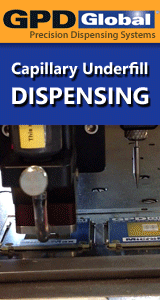Brian, a couple of things really stick out here... 1) You are spraying what is referred to here at the CATT as "PINK DEATH" The 3355-11 is about the most active/aggressive flux you can get your hands on. I am concerned about both the condition of the wave solder machine as well as the spray fluxer. Unless you have setup a super rigourous cleaning schedule, this flux will fairly quickly 'eat' your machine and fluxer. 2) You're running a conveyor speed of 3 ft./min. Without knowing details like the board thickness, density, etc., I would be inclined to say that this slow of a speed would not be necessary given the high activity of flux. It is possible that your 'defect' (some of our customers would kill to have this kind of problem)is a result of the Super Wetting Syndrone. Naturally, this is a fictitous term but you get the idea. My suggestion would be to first try running a board at a faster conveyor speed. Or, if you don't want to re-adjust your preheat to match the new speed, you can run the board at 3 ft/min through the PH, and then quickly change the speed via the keypad to something like 5 or 6 ft/min just before the board enters the wave. This will help to identify whether or not your dwell time is excessive for this particular flux and/or situation. Less dwell time could possibly alleviate this 'problem'. My second suggestion would be to decrease your flux deposition rate. I don't know what type of spray fluxer you're using, but I would say try cutting it in half. When using 3355-11, it only takes a pinch to do the job. Less wetting forces mean less wicking. Less wicking means less top-side hole fill. Now, you say that it doesn't occurr on every cap every time. This could be an indication that there is either a contamintion issue with some of the leads, or an oxidation problem if the parts have been sitting around for excessive periods of time. It could also be due to fluxer performance issues. The fluxer could be performing erraticly and depositing a non-uniform layer of flux on the board. Or, if you'd like to talk to me personally, you can contact me at 972-606-1900 x183 I am the SW regional Product Specialist for Wave Solder here at Speedline/Electrovert. deposition | The Lonco 3355-11 flux is sprayed on. The Electrovert Ultra2000 conveyor speed is at 3.00 ft/min and the solder bath is set at 480 F. The temperature and conveyor speeds are verified on a dailly basis per our P.M. setup. A QA audit profile is also done once every 3 days to substantiate maintenance's findings. | This does not happen to other capacitors, nor does it occur on the same capacitors on a consistent basis. Rather, on a board with 16 capacitors that are arranged in no uniform pattern, will have 3 to 4 capacitors with this issue. The next board will have the same number of defects, but on different capacitors. | My thinking is starting to slide towards the Axial insertion of the component in relationship to the smaller dia. of the lead. What do ya think?
reply »
![]()
![]() I am experiencing a wave-soldering problem with a leaded c...
- Jun 23, 1998
by
I am experiencing a wave-soldering problem with a leaded c...
- Jun 23, 1998
by
![]()
![]() | I am experiencing a wave-soldering problem with a leaded...
- Jun 23, 1998
by
| I am experiencing a wave-soldering problem with a leaded...
- Jun 23, 1998
by
![]()
![]() | | I am experiencing a wave-soldering problem with a lead...
- Jun 24, 1998
by
| | I am experiencing a wave-soldering problem with a lead...
- Jun 24, 1998
by
![]()
![]() What is your current solder pot temperature? Whatever tha...
- Jun 24, 1998
by
What is your current solder pot temperature? Whatever tha...
- Jun 24, 1998
by
![]()
![]() | What is your current solder pot temperature? Whatever...
- Jun 24, 1998
by
| What is your current solder pot temperature? Whatever...
- Jun 24, 1998
by
![]()
![]() Brian, a couple of things really stick out here...
1) You...
- Jun 24, 1998
by
Brian, a couple of things really stick out here...
1) You...
- Jun 24, 1998
by







